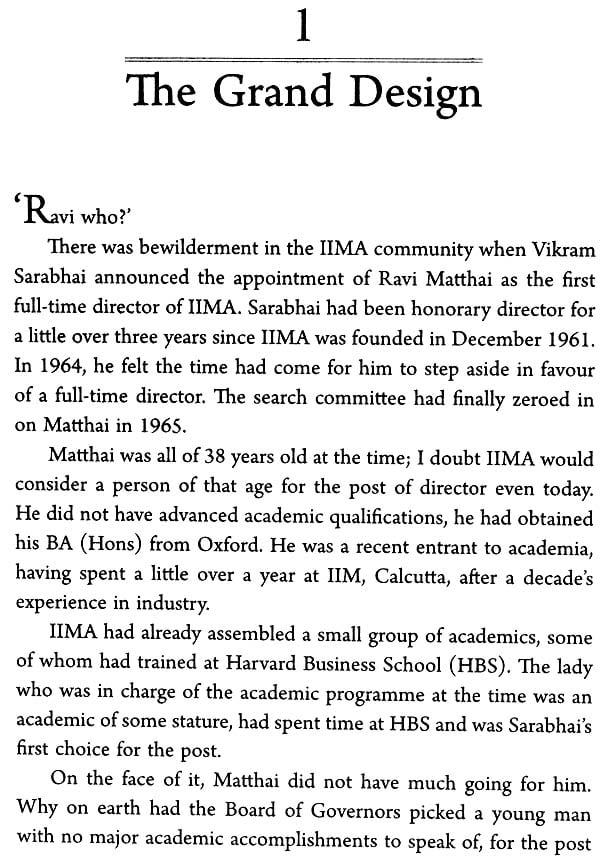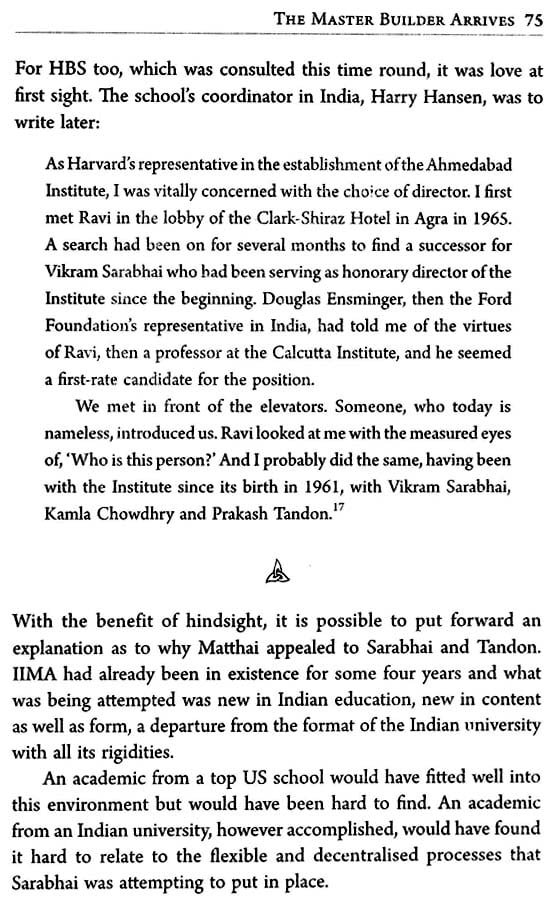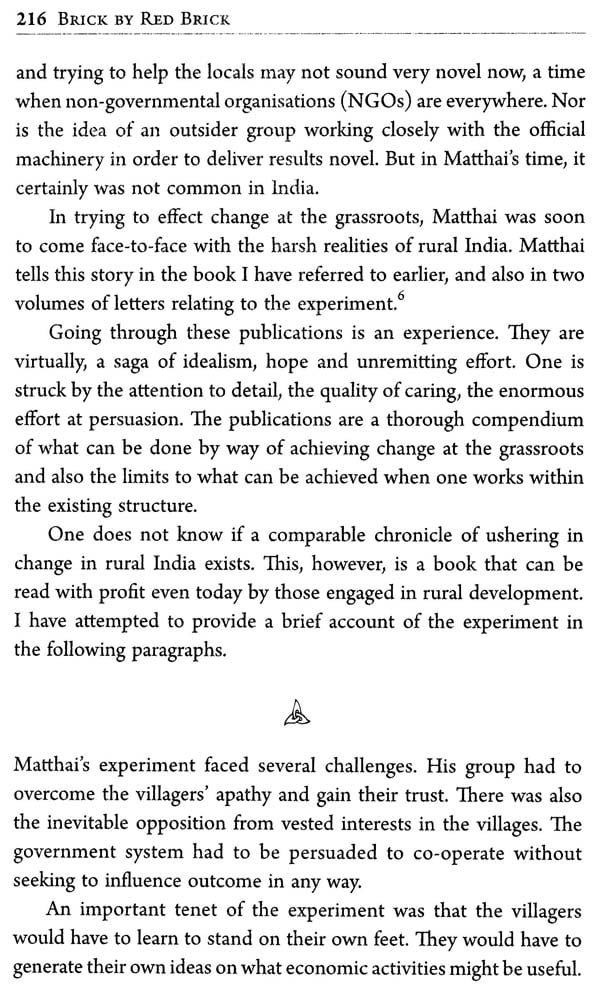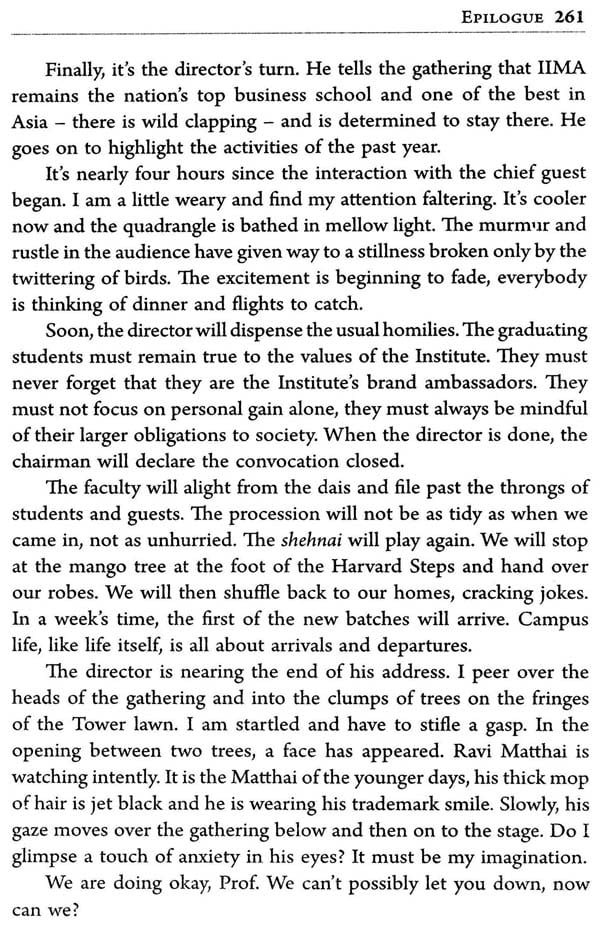
Brick by Red Brick (Ravi Mitthai and The Making of IIM Ahmedabad)
Book Specification
| Item Code: | NAP517 |
| Author: | Ravi Matthai |
| Publisher: | Rupa Publication Pvt. Ltd. |
| Language: | English |
| Edition: | 2011 |
| ISBN: | 9788129117861 |
| Pages: | 295 |
| Cover: | Hardcover |
| Other Details | 9.0 inch X 6.0 inch |
| Weight | 530 gm |
Book Description
IIM Ahmadabad, Which will soon complete fifty years of existence, has been the nation's preeminent management institution for several decades now.
A little over three years after it was set up, Vikram Sarabhai chose a young corporate executive, Ravi Matthai to head the team of academics he had assembled at IIMA, many f the trained at Harvard Business School. Matthai was all of thirty-eight years old when he was appointed the institute's first full-time director. He was not an academic by training and yet Matthai turned out to be absolutely the right choice. Building on the foundation laid by Sarabhai Matthai went on to create a vibran institution using principles that were highly evolved for his time and quite unique in the world of education.
This book tells the story of how IIMA was conceived , its distinctive governance structures its unique culture- and how a highly gifted manager created the conditions for its enduring success. It gives the reader a peep into the inner workings of one of India's most admired academic institutions . It shows how IIMA's success was not accident but the result of the vision and dedicated effort of a remarkable leaded, a pioneer in management education in India.
T T Ram Mohan graduated from IIT Bombay, and IIM Calcutta, and obtained his doctorate from Stern School of Business, New York University. He worked in consultancy and the financial sector before entering academics . For over decade now, he has been writing a fortnightly column for The Economic Times .
He has authored three books He has served on important committees and is currently on the boards of several companies.
It’s the exposed red brick structure that strikes you when arrive at the old campus of the Indian Institute of Management, Ahmadabad. The tall Asopalav trees that stand like sentinels lined up against the fortress-like formations of the student dormitories are another striking feature. The architecture conveys an impression of solidity, of something built to last.
The founding father of IIMA’s did more than create solid buildings. They laid the foundation for IIMA’s enduring success. This book is an account of their stupendous efforts, and in particular, of the role of one man – Ravi Mathhai – the Institute’s first full- time director. It is not a biography of Mathai, it is a story of institution –building in which Mathhai is the leading actor. This is y own endeavour. It is not supported by the Institute in any way except for the facilities I am entitled to as faculty member.
I had heard of Ravi Mathhai when I joined the Institute in late 1998 but did not know much about him. A few month is after I had joined, I attended a function to welcome the new batch of students in the two-year post-graduate programme. In a routine address that lasted just about 15 minutes, the then director invoked Mathhai thrice. In the first couple of years, I noticed that many of the important processes or initiatives in the Institute were traced back to Matthai’s time.
These early impressions – of a larger-than-life figure-stayed with me. One day, I stumbled upon a collection of Matthai’s speeches and writings. Going through the papers, I was struck by the quality of his writings. It was evident that this was a man who had thought trough the IIMA experiment with great care.
On the occasion of the forty-eighth anniversary of IIMA, I Penned a portrait of Mathhai in my column in The Economic Times. I was touched by the response it evoked. The article seemed to have struck a chord with many people.
Among these who responded was Shreekant Sambrani, a former faculty member of IIMA. Sambrani proposed that we collaborate on a biography of Mathhai. I agreed. Thereafter, I did not hear from him. But the idea of a book on Mathhai and IIMA had been planted in my mind.
Sometime in 2009 preparations commenced at the Institute for celebrating its golden jubilee (starting in December 2010). I revisited the idea. The timing was perfect. But I hesitated. Did a mere director of a management institution merit a book?
Also, the documentation at the Institute was patchy. But it had preserved on CDs a set of papers of Sarabhai containing letters and memoranda relating to the formative years. I used these to get started. The first two chapters draw heavily on them.
On Matthai’s ideas, there was enough material. But I was stuck when it came to chronicling the events in his tenure. I could put together some important happenings by talking to people, but this was far from adequate.
By a stroke of luck, one day, the minutes of the Faculty Council meetings held in Matthai’s time landed on my lap, as it were. The minutes were thorough enough to add up to a chronicle of the period. It was just what I needed. Much of chapters 4 and 5 are based on these minutes.
I had been a student at IIMC. During my stay there and also after I joined IIMA, I had often wondered what gave IIMA its premium rating. the three older IIMs – IIMA, IIMB and IIMC – all have access to the same pool of faculty and student talent. All have been handsomely supported by the government. So what was special about IIMA?
To many of us at IIMA, the answer seems obvious enough: IIMA had the benefit of Matthai’s leadership whereas the others did not. It was mainly on account of Matthai’s leadership that IIMA quickly established itself as the nation’s pre-eminent management institution. And it has stayed at the top ever since. In a milieu in which institutions of higher learning seem almost fated to decline with time, this is a noteworthy achievement. How IIMA has been able to manage that is worth studying.
Contents
| Acknowledgements | ix | |
| Preface | xi | |
| 1 | The Grand Design | 1 |
| 2 | Laying the Foundation | 27 |
| 3 | The Master Builder Arrives | 58 |
| 4 | Erecting the Edifice | 81 |
| 5 | Towering Over the Rest | 114 |
| 6 | Getting the 'Software' Right | 147 |
| 7 | Light and Shadow | 179 |
| 8 | At the Grassroots | 209 |
| 9 | Stylw and Substance | 234 |
| BOXES | ||
| 1.1 | Institutions are not always planned, they just happen | 11 |
| 2.1 | Is management a science? | 33 |
| 3.1 | A corporate executive turns academic | 71 |
| 4.1 | An emphasis on excellence in teaching | 92 |
| 4.2 | Spotting talent: C K Prahalad | 103 |
| 5.1 | Can management be taught? | 123 |
| 6.1 | Management 2.0 | 173 |
| 7.1 | The Bhagava Reports | 200 |
| 8.1 | Jawaja Kiya Who Nibhana Padega…' | 225 |
| 9.1 | A matter of foreign exchange | 240 |
| 9.2 | The human touch | 246 |
| Epilogue | 255 | |
| Notes | 262 | |
| List of Acronyms | 269 | |
| Bibliography | 270 | |
| Index | 271 |
Sample Pages









